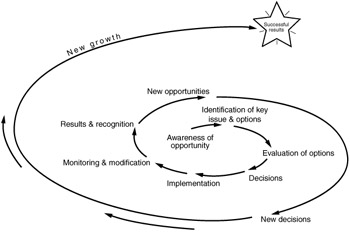The Keys to Step 9
The Keys to Step #9
Be Fearless in the Face of Change
Why do typical decision processes fall short of their mark? A prime factor is participants who try to prove their own individual points of view. They lock their groups into an us-versus-them dynamic. The "victors" glory in their success, which is often short-lived. The "losers" look for ways to prove themselves right and frustrate implementation of the solution. After battling to a final decision, no one has the energy to revisit the decision anytime soon. Participants often feel that too much has already been invested; thus, they become stuck in outdated decisions.
In our conflict-ridden culture, where opponents pit themselves against one another, people deride leaders who change their minds. But changing direction is not necessarily bad. Most criticism arises as the consequence of people overselling previously held points of view. In their zeal to "win" or demonstrate that they had the best idea, they refuse to acknowledge alternatives or recognize events that warrant change. Using Step #9 in particular and the entire ten-step process in general protects you from becoming victim to these debilitating dynamics.
Keep the Learning Cycle Working
Think of decision making as an ongoing process rather than as a specific end result. As Part 1 pointed out, you can visualize decision making as a continuous learning loop. The loop begins with the awareness of change and proceeds through the consideration of options, the selection of a desirable direction and viable alternatives, and then implementation of a chosen solution. It concludes with monitoring and modifying the chosen direction as new changes occur. Successful organizations move continuously through the learning loop. (See Figure 15.)

Figure 15: Continue the learning cycle to succeed.
Where is your organization stuck? What changes have occurred with which your decisions and solutions haven't kept pace? Are people denying change or avoiding it because they don't have viable alternatives? Maybe you have a product that isn't selling well, an inefficient production system, or team members who aren't playing effectively off each other's strengths. Wherever your problems are occurring, the ten-step process, and Step #9 in particular, will pull your group out of its rut.
EAN: 2147483647
Pages: 112